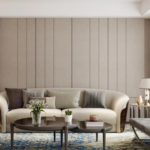When evaluating outdoor furniture, you’re probably going to look for many of the same characteristics that you value in indoor tables, chairs and sofas – durability, comfort and style (and of course price). The primary difference, however, is that patio furniture has to endure exposure to the weather outside. While there is virtually no 100% weatherproof patio furniture, there are big differences based on the materials used. Before you decide, it’s important to understand the strengths and weaknesses of various material options. Determine how well each aligns with the requirements of your residential or commercial environment, as well as your personal preferences and priorities.
Materials for Outdoor Furniture Frames and Tabletops
Wood
Wood has been a popular raw material for furniture for millennia. It has a natural beauty, is generally easy to work with and provides a sturdy framework for tables, chairs, benches and other furnishings. However, not all woods are created equal when it comes to outdoor usage. Many softwoods, such as pressure-treated pine, cedar and fir are inexpensive and widely used for indoor furnishings, but do not stand up well to the elements and need constant protection when not in use. Hardwoods, on the other hand, are much heartier, resist weather damage and can last decades if treated properly. On the downside, they are often more difficult to shape and are typically more expensive than softwoods. But, there are major differences between hardwoods too.
Teak
Teak is easily the most popular wood choice for outdoor furniture. Its high demand, coupled with limited availability, has pushed the price of this fine-grained hardwood extremely high. Fortunately, teak has many characteristics that make it ideally suited for outdoor use. It is incredibly strong and doesn’t warp, crack or become brittle like many kinds of wood. This is because teak repels most water and does not expand or contract in the drying process. It has a high natural oil content, which makes it highly resistant to damage from rot, decay and insects. This durability against the elements enables team to last the longest – up to fifty years! It’s gorgeous honey brown appearance can be maintained with minimal oiling or it can patina into an attractive silver-gray over time, if left untreated. Most patio furniture brands have at least a few pieces made from this handsome wood.
Metal
Metal is typically the strongest and most durable material for outdoor garden furniture. Because of its strength, metallic frames can be thinner and shaped into more complex designs than other options, giving manufacturers greater style flexibility.
Other Hardwoods
There are a number of other hardwoods that share some of the positive qualities of teak at a much lower price point. However, they also have drawbacks relative to the hardwoods mentioned above. Reddish-brown acacia (a.k.a. locust) is readily available but is more likely to warp or crack than shore or eucalyptus. Roble is scarce, lightweight and lasts half as long as teak, while African iroko is very hard to work with, easily splinters and blunts woodworking tools. Mahogany has a beautiful reddish tint, but is coarse, requires a lot of maintenance and doesn’t handle rot as well as teak.





